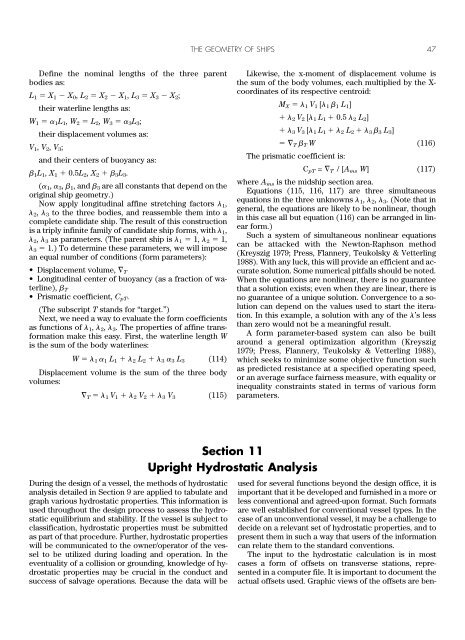The Geometry of Ships
Create successful ePaper yourself
Turn your PDF publications into a flip-book with our unique Google optimized e-Paper software.
THE GEOMETRY OF SHIPS 47<br />
Define the nominal lengths <strong>of</strong> the three parent<br />
bodies as:<br />
L 1 X 1 X 0 , L 2 X 2 X 1 , L 3 X 3 X 2 ;<br />
their waterline lengths as:<br />
W 1 1 L 1 , W 2 L 2 , W 3 3 L 3 ;<br />
their displacement volumes as:<br />
V 1 , V 2 , V 3 ;<br />
and their centers <strong>of</strong> buoyancy as:<br />
1 L 1 , X 1 0.5L 2 , X 2 3 L 3 .<br />
( 1 , 3 , 1 , and 3 are all constants that depend on the<br />
original ship geometry.)<br />
Now apply longitudinal affine stretching factors 1 ,<br />
2 , 3 to the three bodies, and reassemble them into a<br />
complete candidate ship. <strong>The</strong> result <strong>of</strong> this construction<br />
is a triply infinite family <strong>of</strong> candidate ship forms, with 1 ,<br />
2 , 3 as parameters. (<strong>The</strong> parent ship is 1 1, 2 1,<br />
3 1.) To determine these parameters, we will impose<br />
an equal number <strong>of</strong> conditions (form parameters):<br />
• Displacement volume, T<br />
• Longitudinal center <strong>of</strong> buoyancy (as a fraction <strong>of</strong> waterline),<br />
T<br />
• Prismatic coefficient, C pT .<br />
(<strong>The</strong> subscript T stands for “target.”)<br />
Next, we need a way to evaluate the form coefficients<br />
as functions <strong>of</strong> 1 , 2 , 3 . <strong>The</strong> properties <strong>of</strong> affine transformation<br />
make this easy. First, the waterline length W<br />
is the sum <strong>of</strong> the body waterlines:<br />
W 1 1 L 1 2 L 2 3 3 L 3 (114)<br />
Displacement volume is the sum <strong>of</strong> the three body<br />
volumes:<br />
T 1 V 1 2 V 2 3 V 3 (115)<br />
Likewise, the x-moment <strong>of</strong> displacement volume is<br />
the sum <strong>of</strong> the body volumes, each multiplied by the X-<br />
coordinates <strong>of</strong> its respective centroid:<br />
M X 1 V 1 [ 1 1 L 1 ]<br />
2 V 2 [ 1 L 1 0.5 2 L 2 ]<br />
3 V 3 [ 1 L 1 2 L 2 3 3 L 3 ]<br />
T T W (116)<br />
<strong>The</strong> prismatic coefficient is:<br />
C pT = T / [A ms W] (117)<br />
where A ms is the midship section area.<br />
Equations (115, 116, 117) are three simultaneous<br />
equations in the three unknowns 1 , 2 , 3 . (Note that in<br />
general, the equations are likely to be nonlinear, though<br />
in this case all but equation (116) can be arranged in linear<br />
form.)<br />
Such a system <strong>of</strong> simultaneous nonlinear equations<br />
can be attacked with the Newton-Raphson method<br />
(Kreyszig 1979; Press, Flannery, Teukolsky & Vetterling<br />
1988). With any luck, this will provide an efficient and accurate<br />
solution. Some numerical pitfalls should be noted.<br />
When the equations are nonlinear, there is no guarantee<br />
that a solution exists; even when they are linear, there is<br />
no guarantee <strong>of</strong> a unique solution. Convergence to a solution<br />
can depend on the values used to start the iteration.<br />
In this example, a solution with any <strong>of</strong> the ’s less<br />
than zero would not be a meaningful result.<br />
A form parameter-based system can also be built<br />
around a general optimization algorithm (Kreyszig<br />
1979; Press, Flannery, Teukolsky & Vetterling 1988),<br />
which seeks to minimize some objective function such<br />
as predicted resistance at a specified operating speed,<br />
or an average surface fairness measure, with equality or<br />
inequality constraints stated in terms <strong>of</strong> various form<br />
parameters.<br />
During the design <strong>of</strong> a vessel, the methods <strong>of</strong> hydrostatic<br />
analysis detailed in Section 9 are applied to tabulate and<br />
graph various hydrostatic properties. This information is<br />
used throughout the design process to assess the hydrostatic<br />
equilibrium and stability. If the vessel is subject to<br />
classification, hydrostatic properties must be submitted<br />
as part <strong>of</strong> that procedure. Further, hydrostatic properties<br />
will be communicated to the owner/operator <strong>of</strong> the vessel<br />
to be utilized during loading and operation. In the<br />
eventuality <strong>of</strong> a collision or grounding, knowledge <strong>of</strong> hydrostatic<br />
properties may be crucial in the conduct and<br />
success <strong>of</strong> salvage operations. Because the data will be<br />
Section 11<br />
Upright Hydrostatic Analysis<br />
used for several functions beyond the design <strong>of</strong>fice, it is<br />
important that it be developed and furnished in a more or<br />
less conventional and agreed-upon format. Such formats<br />
are well established for conventional vessel types. In the<br />
case <strong>of</strong> an unconventional vessel, it may be a challenge to<br />
decide on a relevant set <strong>of</strong> hydrostatic properties, and to<br />
present them in such a way that users <strong>of</strong> the information<br />
can relate them to the standard conventions.<br />
<strong>The</strong> input to the hydrostatic calculation is in most<br />
cases a form <strong>of</strong> <strong>of</strong>fsets on transverse stations, represented<br />
in a computer file. It is important to document the<br />
actual <strong>of</strong>fsets used. Graphic views <strong>of</strong> the <strong>of</strong>fsets are ben-



